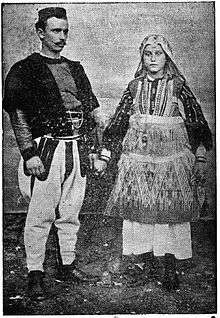Doksim Mihailović
| Vojvoda Doksim Mihailović | |
|---|---|
 Doksim and his wife. | |
| Nickname(s) | |
| Born |
20 February 1883 Galičnik, Sanjak of Dibra, Manastir Vilayet, Ottoman Empire (now R. Macedonia) |
| Died |
24 October 1912 (aged 29) Kumanovo, Sanjak of Üsküp, Ottoman Empire (now R. Macedonia) |
| Buried at | Mlado Nagoričane |
| Allegiance | |
| Years of service | 1904–1912 |
| Rank | vojvoda |
Doksim Mihailović (Serbian: Доксим Михаиловић; 20 February 1883 – 24 October 1912) was a Macedonian Serb voivode (military commander), originally a teacher, who joined the Serbian Chetnik Organization to fight in Ottoman Macedonia, and then the Balkan Wars (in the army of the Kingdom of Serbia). Originally a teacher, he fought against the Ottomans army and later Bulgarian guerrilla bands in the Kosovo Vilayet.
Life
Doksim was born in Galičnik, a Mijak village.[2] He finished the theological school in Prizren, and was a teacher in his home region until 1904,[3] when he joined the Serbian Chetnik Organization. In January 1905, vojvoda Gligor Sokolović sent Stefan Nedić-Ćela from Babuna to Vranje to bring new Chetniks and Doksim.[4]
He was one of many teachers who were voivodes.[5] He participated in the Battle of Čelopek (1905), which had been glorified as a great victory.[3] In 1906 he lost his teacher wage.[6]
After the guerrilla war, he went to Mount Athos, where he worked as the estate manager of the Hilandar.[3] He returned to Macedonia and married, then worked as a principal at Serbian schools in Gevgelija.[3] After that, he went to Greece and Malta and worked in trade; Doksim spoke Greek and Turkish since youth, and later taught Arabic and Italian.[3]
When the First Balkan War started, he immediately took up arms and founded his own band, and joined vojvoda Vojin Popović-Vuk, at the front of the Serbian Army.[3] Prior to the start of the First Balkan War, Chetniks gathered in Vranje from several regions: 160 in Vranje and 30 on the Kozjak with the voivodes Babunski, Ćela, Dolgač, Trpko, Dane, Vanđel, Doksim and Cakić; there were also 60 Chetniks which readied for Poreče, led by Vojvoda Vuk.[3] These bands were the first to have crossed the border, cleaned the ground, built bridges and prepared important positions such as Kozjak, Stracin, and others.[3] Doksim fought the Ottomans at Kozjak.[3] The bands were also accompanied by armed peasants, thus numbering four groups of around 250 men.[3] The Chetniks were the first to enter Prilep, then fought in the front lines in the battles for Bitola and Kičevo.[3] Doksim died on the second day of the battle of Kumanovo.[3] He was buried on a hill above the village of Mlado Nagoričane.[3]
References
- 1 2 Vladimir Dedijer; Života Anić; Srpska akademija nauka i umetnosti. Odeljenje istorijskih nauka (2008). Dokumenti o spoljnoj politici Kraljevine Srbije: dodat. 1-3. Srpska akademija nauka i umetnosti.
- ↑ Serbian ethnographic series. Srpska akademija nauka i umetnosti. 1925. p. 37.
За време четничке акције Мијаци су били подељени уз Србе и Бугаре. Српски војвода је био Доксим Михаиловић из Галичника, који је погинуо 10. октобра 1912. г. код Куманова. Бугарски војвода је био Максим Н. Богоја, који је ...
- 1 2 3 4 5 6 7 8 9 10 11 12 13 Simo Živković (December 1998). "Sakupi se jedna četa mala". Srpsko-nasledje.rs. Retrieved 2011-08-12.
- ↑ Tanasije M. Stojanović (1937). Kroz ograšje. Udruženje ratnih invalida. p. 61.
Прешли су са њима и Стеван Недић-Ћела, кога је у јануару 1905. Глигор са Бабуне послао да у Врању скупи нове четнике и галичнички учитељ Доксим Михајловић. Обећао је своме пријатељу турском миљазиму Босанцу – Србину муслиману из Сарајева – да ће се у Галичник са четом вратити. ...
- ↑ Ilić, Vladimir. "Prvi gorski štabovi: Planina Kozjak bila glavno uporište".
Učitelji - vojvode bili su: Jovan Dovezenski, Jovan Babunski, Rade Radivojević - Dušan Vardarski, Lazar Kujundžić - Klempa i Doksim Mihailović - Debarac.
- ↑ Gligor Todorovski (1970). Malorckanskiot predel. p. 238.
Sources
- Books
- Krakov, Stanislav (1990) [1930]. Plamen četništva (in Serbian). Belgrade: Hipnos.
- Trbić, Vasilije (1996). Memoari: 1898-1912 (in Serbian). Kultura.
- Mitropan, Petar (1933). Прилози за историју штампе у Старој Србији и Македонији 1871-1912. Skoplje. p. 55.
- Pejčić, Predrag (2007). Четнички покрет у Краљевини Србији. Kragujevac. pp. 137, 142–144.
- Pešić, Miodrag D. (2000). Стари четници. Kragujevac: Novi Pogledi.
- Vladimir Dedijer; Života Anić; Radovan Samardžić (2006). Dokumenti o spoljnoj politici Kraljevine Srbije: sv. 2 15. Srpska akademija nauka i umetnosti, Odeljenje istorijskih nauka. p. 458.
Мство, упитано да ли је Доксим дошао са знањем његовим и Голуба Јањића, одговорило је синоћ депешом: да је Доксим са свима у Београду раскрстио, да је дигао руке од свега и да се враћа кући у Галичник. Ипак не изгледа да [...] Дођоше Доксим Михаиловић и Драгиша Стојадиновић, техни- чар I год. Како се раније проносило да Доксим намерава убити Ристи- ћа, то смо сад мислили да су ова двојица због тога дошла. Ристић по- звао и једног и другог и у ...
- Vladimir Dedijer; Života Anić; Radovan Samardžić (2003). Dokumenti o spoljnoj politici Kraljevine Srbije. 2. Srpska akademija nauka i umetnosti, Odeljenje istorijskih nauka. p. 315.
Таква бојазан нагнала ме је, да Вам, Господине Министре, предложим један покушај. - Са универзитетским певачким друштвом „Обилић". које је о Св. Сави овде концертирало, дошао је и Доксим Михаиловић, бивши учитељ у ...
| Wikimedia Commons has media related to Doksim Mihailović. |